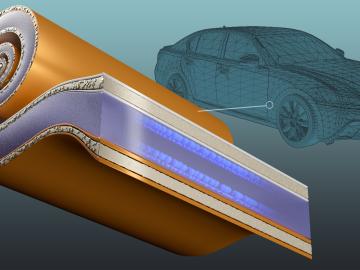
Filter News
Area of Research
- Advanced Manufacturing (1)
- Biology and Environment (5)
- Energy Science (71)
- Fusion and Fission (8)
- Fusion Energy (7)
- Materials (47)
- Materials for Computing (5)
- National Security (4)
- Neutron Science (15)
- Nuclear Science and Technology (16)
- Nuclear Systems Modeling, Simulation and Validation (1)
- Quantum information Science (1)
- Supercomputing (14)
- Transportation Systems (2)
News Topics
- (-) Advanced Reactors (40)
- (-) Molten Salt (10)
- (-) Physics (69)
- (-) Transportation (103)
- 3-D Printing/Advanced Manufacturing (146)
- Artificial Intelligence (131)
- Big Data (79)
- Bioenergy (112)
- Biology (128)
- Biomedical (73)
- Biotechnology (39)
- Buildings (74)
- Chemical Sciences (86)
- Clean Water (33)
- Composites (35)
- Computer Science (226)
- Coronavirus (48)
- Critical Materials (29)
- Cybersecurity (35)
- Education (5)
- Element Discovery (1)
- Emergency (4)
- Energy Storage (114)
- Environment (218)
- Exascale Computing (67)
- Fossil Energy (8)
- Frontier (64)
- Fusion (66)
- Grid (74)
- High-Performance Computing (130)
- Hydropower (12)
- Irradiation (3)
- Isotopes (62)
- ITER (9)
- Machine Learning (68)
- Materials (157)
- Materials Science (158)
- Mathematics (12)
- Mercury (12)
- Microelectronics (4)
- Microscopy (56)
- Nanotechnology (64)
- National Security (86)
- Neutron Science (171)
- Nuclear Energy (122)
- Partnerships (68)
- Polymers (35)
- Quantum Computing (53)
- Quantum Science (93)
- Security (31)
- Simulation (65)
- Software (1)
- Space Exploration (26)
- Statistics (4)
- Summit (71)
Media Contacts

Strengthening the competitiveness of the U.S. transportation industry depends on developing domestic EV batteries that combine rapid charging with long-range performance — two goals that often conflict. Researchers at ORNL have addressed this challenge by redesigning a key battery component, enabling fast, 10-minute charging while improving energy density and reducing reliance on copper.

Analyzing massive datasets from nuclear physics experiments can take hours or days to process, but researchers are working to radically reduce that time to mere seconds using special software being developed at the Department of Energy’s Lawrence Berkeley and Oak Ridge national laboratories.
Scientists at ORNL have developed a method that can track chemical changes in molten salt in real time — helping to pave the way for the deployment of molten salt reactors for energy production.

During his first visit to Oak Ridge National Laboratory, Energy Secretary Chris Wright compared the urgency of the Lab’s World War II beginnings to today’s global race to lead in artificial intelligence, calling for a “Manhattan Project 2.”

Using the Frontier supercomputer at ORNL, researchers have developed a new technique that predicts nuclear properties in record detail. The study revealed how the structure of a nucleus relates to the force that holds it together. This understanding could advance efforts in quantum physics and across a variety of sectors, from to energy production to national security.

Scientists at ORNL are using advanced germanium detectors to explore fundamental questions in nuclear physics, such as the nature of neutrinos and the matter-antimatter imbalance. The ongoing LEGEND project, an international collaboration, aims to discover neutrinoless double beta decay, which could significantly advance the understanding of the universe.
Vivek Sujan, a distinguished R&D scientist in the Applied Research for Mobility Systems group at ORNL, has been named a 2024 National Association of Inventors Fellow for his numerous transportation-related patents.

Scientists designing the world’s first controlled nuclear fusion power plant, ITER, needed to solve the problem of runaway electrons, negatively charged particles in the soup of matter in the plasma within the tokamak, the magnetic bottle intended to contain the massive energy produced. Simulations performed on Summit, the 200-petaflop supercomputer at ORNL, could offer the first step toward a solution.

ORNL’s annual workshop has become the premier forum for molten salt reactor, or MSR, collaboration and innovation, convening industry, academia and government experts to further advance MSR research and development. This year’s event attracted a record-breaking 365 participants from across the country, highlighting the momentum to bring MSRs online.


